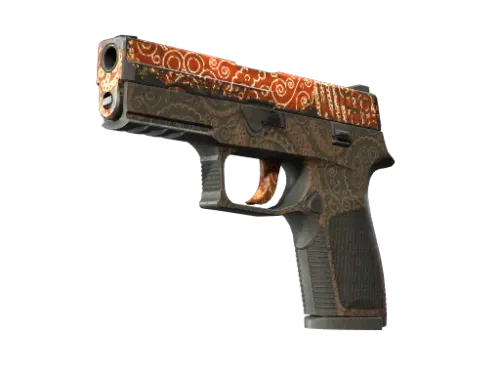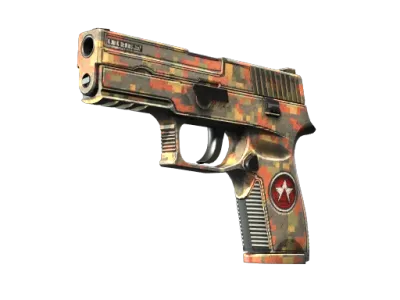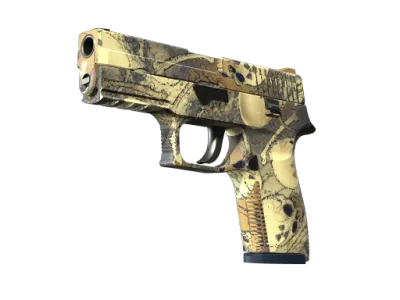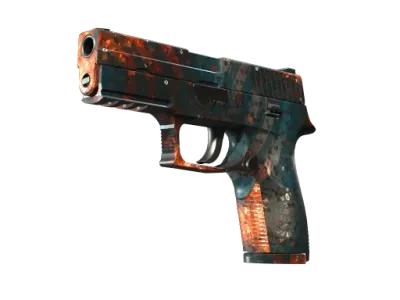colors
Contêineres
Coleções
Estatísticas de preços
Último 7 dias
Preço atual
7 Alteração de preço em dias
7 Baixo em dias
7 Alto em dias
30 Baixo em dias
30 Alto em dias
90 Baixo em dias
90 Alto em dias
Mínimo de todos os tempos
Máximo de todos os tempos

StatTrak™ P250 | Mehndi (Gasto)

Da semana passada
-11.03%Do mês passado
-8.05%Ofertas ativas
colors
Estatísticas de preços
Último 7 dias
Preço atual
7 Alteração de preço em dias
7 Baixo em dias
7 Alto em dias
30 Baixo em dias
30 Alto em dias
90 Baixo em dias
90 Alto em dias
Mínimo de todos os tempos
Máximo de todos os tempos
Contêineres
Coleções
Skins similares
Descrição
Visão Geral
O StatTrak™ P250 | Mehndi é uma skin deslumbrante que apresenta designs intrincados estilo mehndi, predominantemente em cores laranja, dourado e verde. Faz parte da The Huntsman Collection e foi lançada em maio de 2014.
Raridade
Classificada como 'Classificada' em termos de raridade, a skin Mehndi tem uma chance de queda relativamente baixa. Juntamente com seu belo design, é uma skin cobiçada entre os jogadores de CS:GO.
História
O P250 | Mehndi foi introduzido no jogo no The Huntsman Weapon Case em 2014 e desde então se tornou um clássico favorito entre a comunidade.
Popularidade
Devido ao seu design tradicional atraente inspirado na arte corporal com henna, o P250 | Mehndi continua a ser uma escolha popular entre os jogadores de CS:GO.
Compatibilidade
Esta skin só pode ser equipada na pistola P250.
Características Únicas
A característica única da skin Mehndi é seu design detalhado, que segue os padrões mehndi indianos e paquistaneses, adicionando um toque exótico à arma do jogador.
Evento
Esta skin foi lançada como parte da atualização que introduziu The Huntsman Weapon Case.
Curiosidades
O P250 | Mehndi foi uma das primeiras skins de arma no CS:GO a incorporar estéticas culturais tradicionais, inspirando muitos outros designs de skins inspirados etnicamente.
Designer da Skin
Projetado por Valve.
Características Técnicas
O design captura com sucesso a obra de arte intrincada típica dos padrões mehndi, utilizando camadas complexas e efeitos de gradiente para imitar o efeito da henna na pele.
Avaliações e Classificações
A skin Mehndi é bem recebida com críticas positivas pela comunidade CS:GO, devido à sua representação da arte tradicional do henna e ao seu esquema de cores vibrantes.
Significado Histórico
Como uma das primeiras skins a introduzir arte cultural no CS:GO, o P250 | Mehndi ocupa um lugar significativo na história do design de skins do CS:GO.
Razões para a Popularidade
A sua popularidade é atribuída à sua estética impressionante, raridade e ao fato de representar uma parte da cultura sul-asiática, atraindo jogadores dessa região.
Eventos Influentes
O lançamento de The Huntsman Weapon Case marcou a introdução de skins culturalmente diversas no CS:GO, como o P250 | Mehndi.
História de Criação
A criação do P250 | Mehndi foi um movimento ousado para incorporar formas de arte tradicionais no jogo, conectando a arte tradicional e os jogos modernos.
Simbolismo e Elementos de Design
O design Mehndi no P250 simboliza alegria, beleza, despertar espiritual e oferta, que são as mesmas sensibilidades associadas ao mehndi em sua forma tradicional.
Conexão Emocional
Para os jogadores de regiões onde a arte mehndi é uma parte integral de sua cultura, esta skin pode ter uma conexão emocional especial, servindo como um lembrete de seu patrimônio cultural.
Impacto na Comunidade
O sucesso do P250 | Mehndi levou à exploração de vários temas culturais no design de skins, incentivando uma exploração detalhada de múltiplas formas de arte tradicional no CS:GO.
Uso nos Esports
O P250 | Mehndi é frequentemente visto em eventos de esports, favorável por seu design único e cores vibrantes.
Histórias de Jogadores
Numerosos jogadores da Ásia do Sul relataram uma sensação de regresso à sua terra natal devido à skin Mehndi, pois ela lhes lembra os padrões de henna que vêem em eventos culturais da vida real.








